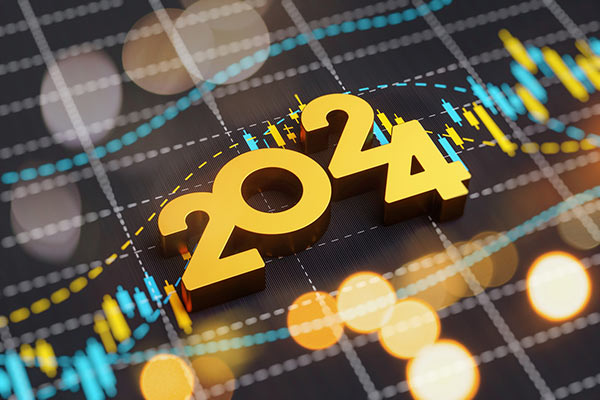Specialist fund and trust tips for 2024
We examine the tailwinds and headwinds for four key specialist areas: technology, healthcare, biotech, and commodities.
9th January 2024 09:47
by Ceri Jones from interactive investor
Share on

Specialist sectors can over the long term add spice to a diversified portfolio, but over short time periods can blow both hot and cold. Therefore, investors need to be prepared to accept the risks are higher than investing in a more mainstream fund, such as those investing in global equities or UK equities.
- Invest with ii: Open an ISA | ISA Investment Ideas | ISA Offers & Cashback
Below, at the start of 2024 we run through the tailwinds and headwinds for four key specialist areas: technology, healthcare, biotech, and commodities.
Healthcare
The future could scarcely look more exciting for many healthcare stocks. Medical advancements in obesity drugs, immunotherapy and cancer treatment are game-changing; genomics and proteomics (the analysis of proteins) are transforming diagnostics; and personalised medicine and machine learning are improving drug development.
At the same time, the ageing population is at tipping point. In 2017, the number of people aged 64 and over exceeded the number of children under five years old, but by 2050, 2.1 billon people (22% of humanity) will be grandparents, and will outstrip the number of under 15s.
Healthcare stocks are also particularly suited to the current uncertain economic environment as they offer steady growth, reliable earnings and high profit margins.
“For investors, the nearest and most important revenue opportunity comes from weight-loss medications,” says Kevin Thozet, a member of the investment committee at Carmignac.
He adds: “Tackling obesity is big business, in more ways than one. With over one in eight adults worldwide overweight and almost half of Americans projected to be obese by 2030, healthcare spending on related conditions is expected to increase. We think the obesity market can go above $100 billion in sales by the early 2030s.”
Novo Nordisk A/S ADR (NYSE:NVO), producer of Ozempic and Wegovy, and Eli Lilly and Co (NYSE:LLY), which manufactures Mounjaro and Zepbound, have seen big rallies and are already on expensive valuations compared with the rest of the sector. But all major pharma are eyeing this opportunity, and not all will be winners. For some obesity drugs, there may be second-order side effects that have not yet played into the data.
- Interest rate fund and trust losers stage a recovery – but will it last?
- Most fund sectors made positive returns in 2023: winners and losers
The impact on the wider drug market will be huge. “Obesity affects 40% of the US adult population and, with 200 related comorbidities, is responsible for up to 14% of the US’s healthcare expenditure,” says Justin Streeter, portfolio manager of Comgest Growth America fund. He points out: “Patients on Lilly’s Zepbound weight-loss drug lose up to 25% of their body weight, and report fewer cravings for junk food and tobacco, while Lilly’s competitor Novo is showing promising results in heart health.”
Mass take up of obesity drugs could prove a headwind for makers of diabetes drugs. Zehrid Osmani, fund manager of the Martin Currie Global Portfolio (LSE:MNP) Trust, notes: “The sector is heavily polarised with GPL-1 drugs proving very successful in attacking obesity and having beneficial effects on the cardiovascular system, but the losers have been impacted heavily and this has gone too far.”
Some commentators have even suggested that wide-scale suppression of appetite will reduce average supermarket basket sizes, hurting food producers and retailers. “At times, the market will chase a thematic and disregard the fundamentals, as happened with green energy a few years ago,” Osmani says.
One way to participate in this theme is through outsourcing organisations known as CDMOs (Contract Development and Manufacturing Organisations) that supply biopharmaceutical products and development and manufacturing services to the industry. Phil Macartney, investment manager in the European equities team at Jupiter, highlights the work of Lonza Group Ltd (SIX:LONN) and Tecan Group AG (SIX:TECN) in Switzerland and WuXi Biologics (SEHK:2269) in China.
This seems sensible given that some parts of traditional healthcare industry still face challenges post pandemic such as lower productivity, pricing pressure, generic competition, and budgetary pressure on healthcare buyers. Price control noise around the US election will also impact sentiment.
Biotech
The biotech sector is heavily dependent on funding. It lagged in 2023 on concern about rising interest rates and inflation. “However long-term trends for the sector remain intact,” says Dzmitry Lipski, head of funds research at interactive investor. He adds: “The growing demand for an age-related disease treatment along with technological advancements such as super-quick development of vaccines and adoption of AI should speed up effective drugs and medicine discoveries.”
Lipski suggests International Biotechnology (LSE:IBT) Trust, which focuses on mid and small-cap companies and even unquoted positions, and offers a dividend yield of 4.4%. It currently trades on over 9% discount.
Another investment trust in the sector is RTW Biotech Opportunities (LSE:RTW). Its fund manager Rod Wong recently appeared on our On The Money podcast to explain why he thinks the sector’s fortunes will change for the better after a volatile couple of years. It is trading on a discount of 16.4%.

Technology
In the broader technology sector, the consensus is that Artificial Intelligence (AI) will be a seismic opportunity across the economy.
“The level of interest in AI is something you rarely see,” says Mike Seidenberg, portfolio manager at Allianz Technology Trust (LSE:ATT). “Companies are putting their best people on it,” he adds.
There are two investment opportunities here: the suppliers enabling companies to use AI and the companies best able to harness it.
It is easy to see that AI is fuelling competition among cloud services platforms, boosting demand for graphics processing units, cloud computing and storage. “The challenge is to see with great foresight how much AI is going to disrupt, and how much companies can harvest the productivity gains,” says Ben Gutteridge, investment director, investment solutions at Invesco.
Gutteridge also warns against extreme valuations, citing that NVIDIA (NASDAQ:NVDA) has twice dropped by 80%. Indeed, Nvidia's chips are made at the Taiwan Semiconductor Manufacturing Co Ltd ADR (NYSE:TSM) factory in the Republic of China Taiwan, another political risk.
- Top 10 most-bought investment funds: December 2023
- Top 10 most-popular investment trusts: December 2023
Of course, there is every reason to be bullish on advanced semiconductors, “given their critical role in the rapid virtualisation of the global economy, leveraging AI trends for enterprise and industrial applications, and as the US and Europe put them at the centre of the race to diversify their supply chains,” says Anjali Bastianpillai, client portfolio manager, thematic equities at Pictet.
Accelerating demand for electric vehicles and advanced driver assistance systems will also benefit auto semiconductors, he says.
Big tech will be right at the forefront of these developments. “There is still a compelling case for businesses that are eminently dominant in their fields and have tremendous pricing power,” says Gutteridge.
He adds: “Currently, the world is focused on slowdown and disinflation and these companies can defend their revenues and margins, even though they get swept up in the macro narrative. Bond yields have risen and yet big tech is up. They are, to a degree, carving their own path and if there is an inflationary resurgence, they have pricing power.”
Microsoft Corp (NASDAQ:MSFT) is particularly well liked by fund managers. “We look for companies that solve difficult, expensive, and time-consuming tasks for their customers,” says Streeter.
He continues: “One example would be Microsoft’s Teams, which can replace a business-class flight and summarise a meeting with AI. Microsoft aims to be the ‘world’s computer’ and is empowering clients to do more with less.”
Commodities
Historically, investors have turned to commodities as a hedge against rising inflation.
Lipski says the outlook for commodities is positive given that the Federal Reserve will start to ease monetary policy – lower interest rates. Moreover, expectations for a weaker US dollar should be positive for commodities priced in dollars. Heightened geopolitical risks and enduring demand for clean energy metals should also support prices.
He suggests WisdomTree Enhanced Commodity ETF (LSE:WCOB) which offers a broad commodity exposure, covering industrial metals, precious metals, energy and agriculture, and should outperform as it tracks the Optimised Roll Commodity index.
In particular, the market may be underestimating the likelihood of higher oil prices. Oil stocks are relatively cheap, particularly in the UK, with sound balance sheets and lots of share buyback activity and dividends.
- Private investors shunning gold miss out on price rally
- Funds and trusts yielding more than cash that the pros are backing
Rare earth materials could also be harder to source if Brussels’ anti-subsidy investigation into Chinese electric vehicles prompts the People’s Republic to retaliate by hoarding.
However, there may be downward pressure on some commodities as mining tech advances, according to Jupiter’s Macartney.
He explains: “Mining machinery could impact the lithium, copper, cobalt and gold markets. Trucks operated remotely can load and haul, and even change their own batteries in minutes, and mines are being mapped to increase the haul. It also meets the green agenda, and you can run a mine at 30% reduced cost as you do not need to extract fumes if the trucks are driven remotely.”
Gold’s run of new highs this year continues to deter new investors while inviting existing owners to take profit.
Adrian Ash, director of research at BullionVault, says gold is still cheaper in real terms than during the first wave of Covid or the financial crash.
He notes: “Geopolitical tensions continue to underpin the market, with the clear move by China and other major emerging markets to reduce their exposure to the dollar driving record-heavy gold demand among Asian central banks.
“However, gold’s famous safe-haven appeal doesn’t work tick-by-tick, and anyone buying gold to offset short-term falls in the stock market is likely to be disappointed.”
These articles are provided for information purposes only. Occasionally, an opinion about whether to buy or sell a specific investment may be provided by third parties. The content is not intended to be a personal recommendation to buy or sell any financial instrument or product, or to adopt any investment strategy as it is not provided based on an assessment of your investing knowledge and experience, your financial situation or your investment objectives. The value of your investments, and the income derived from them, may go down as well as up. You may not get back all the money that you invest. The investments referred to in this article may not be suitable for all investors, and if in doubt, an investor should seek advice from a qualified investment adviser.
Full performance can be found on the company or index summary page on the interactive investor website. Simply click on the company's or index name highlighted in the article.